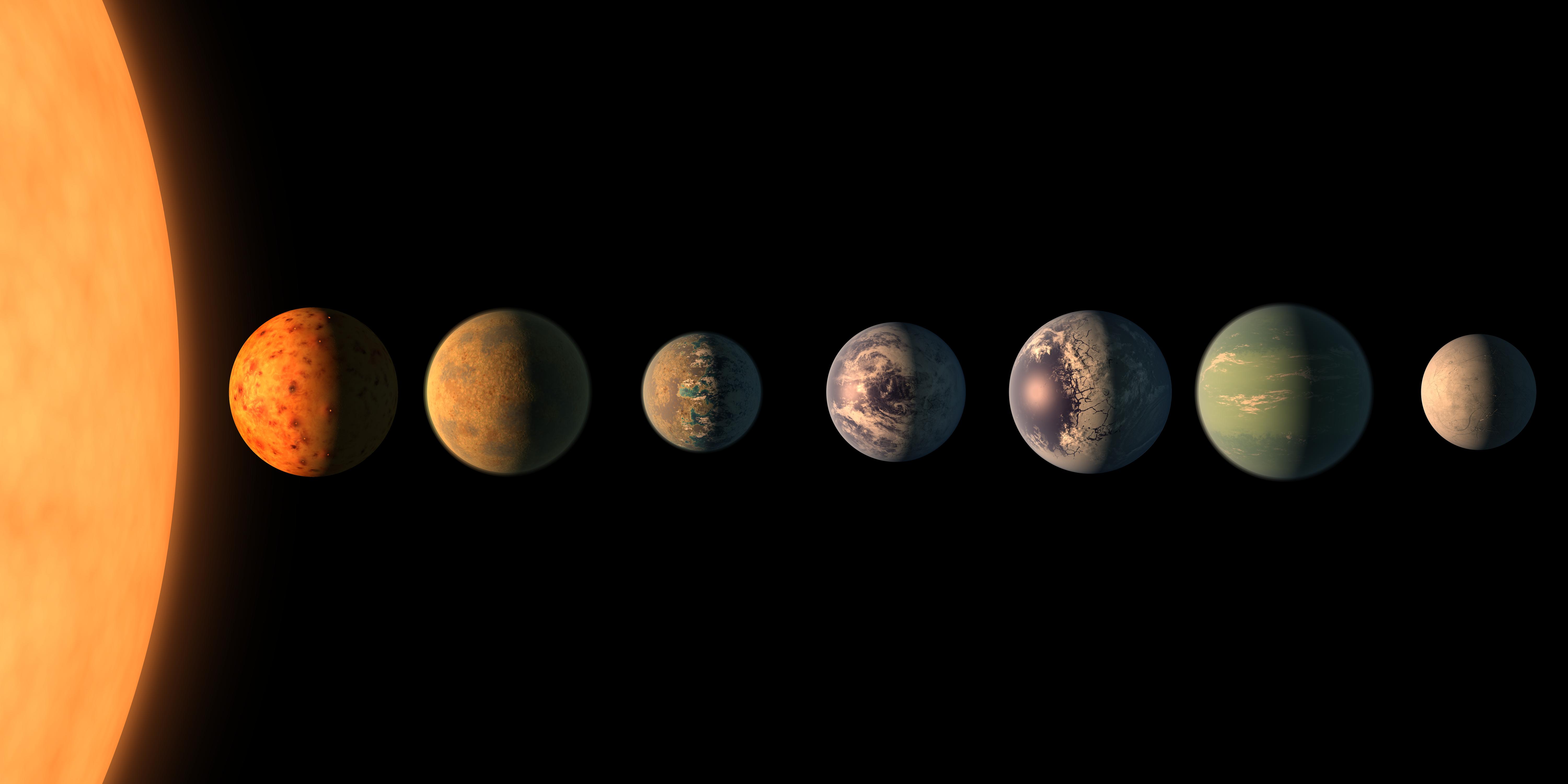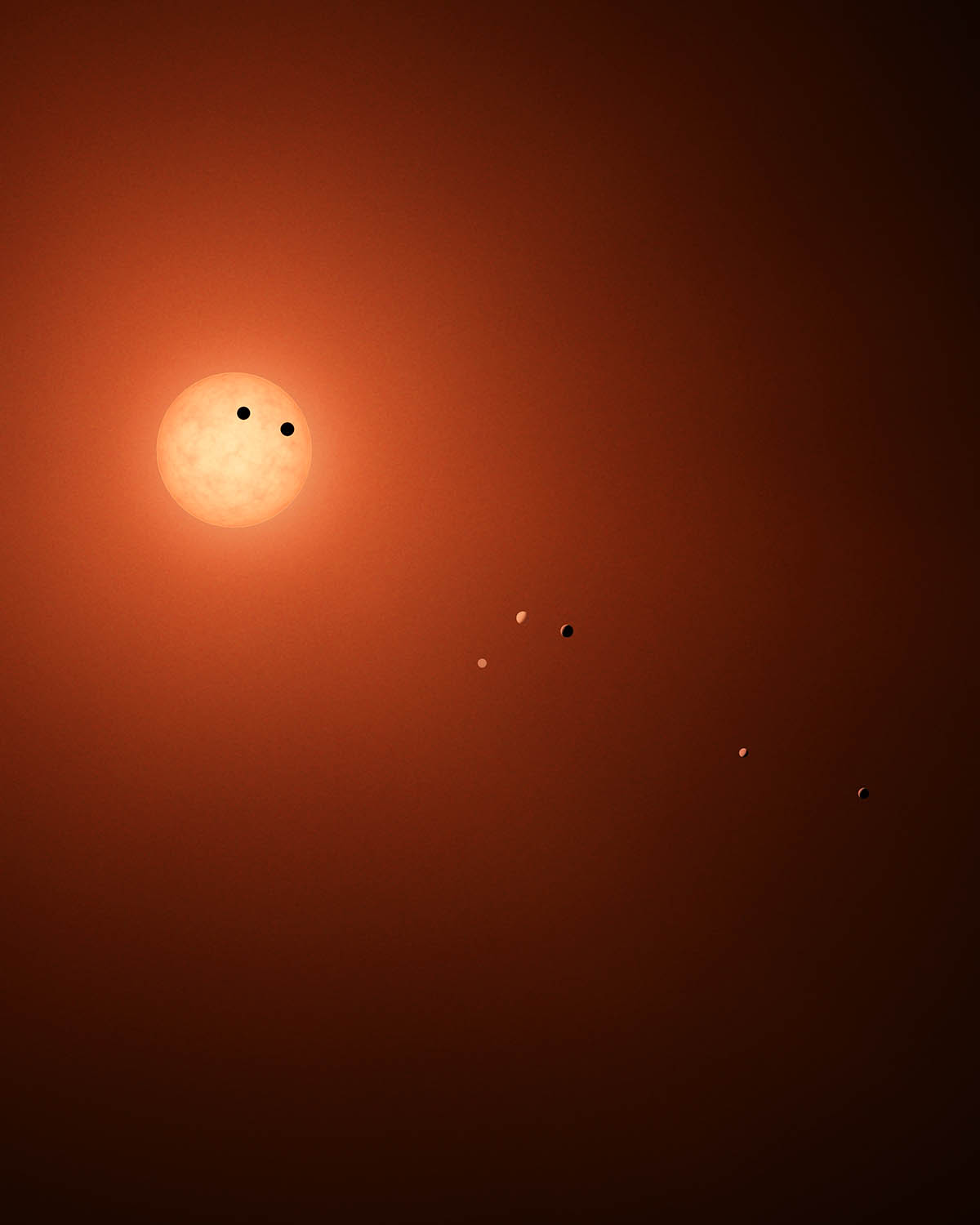
(NASA/JPL-Caltech)
The “first known system of seven Earth-size planets around a single” star, called TRAPPIST-1, has been discovered by the Spitzer Space Telescope, NASA announced during a press conference on February 22.
The exoplanet discovery has been called a major step toward figuring out if there is other life “out there.”
“This discovery could be a significant piece in the puzzle of finding habitable environments, places that are conducive to life,” Thomas Zurbuchen, associate administrator of NASA’s Science Mission Directorate in Washington. “Answering the question ‘are we alone’ is a top science priority and finding so many planets like these for the first time in the habitable zone is a remarkable step forward toward that goal.”
You can watch NASA’s press conference announcing the discovery below:
The new finding sets a record for the greatest number of habitable-zone planets around a single star outside our solar system, NASA says. The announcement that three planet were found was made in May 2016 and NASA announced the additional four discoveries on Wednesday.
The new findings were published Wednesday in the journal Nature.
Here’s what you need to know:
1. The System Is About 40 Light-Years Away From Earth & Is ‘Relatively Close to Us’
The TRAPPIST-1 system is about 40 light-years, or 235 trillion miles, away from Earth, according to NASA.
“The system of planets is relatively close to us, in the constellation Aquarius. Because they are located outside of our solar system, these planets are scientifically known as exoplanets,” NASA says.
“The seven wonders of TRAPPIST-1 are the first Earth-size planets that have been found orbiting this kind of star,” Michael Gillon, lead author of the paper and the principal investigator of the TRAPPIST exoplanet survey at the University of Liege, Belgium. “It is also the best target yet for studying the atmospheres of potentially habitable, Earth-size worlds.”
2. All 7 Planets Could Have Liquid Water Under the Right Atmospheric Conditions, NASA Says

This artist’s concept allows us to imagine what it would be like to stand on the surface of the exoplanet TRAPPIST-1f, located in the TRAPPIST-1 system in the constellation Aquarius. (NASA/JPL-Caltech)
All seven planets in the system could have liquid water under the right atmospheric conditions, NASA says. But the chances are highest with three that are “firmly located in the habitable zone, the area around the parent star where a rocky planet is most likely to have liquid water.”
The research team was able to use the Spitzer telescope data to precisely measure the sizes of the planets and develop estimates of the masses of six of them, allowing their density to also be estimated:
Based on their densities, all of the TRAPPIST-1 planets are likely to be rocky. Further observations will not only help determine whether they are rich in water, but also possibly reveal whether any could have liquid water on their surfaces. The mass of the seventh and farthest exoplanet has not yet been estimated – scientists believe it could be an icy, ‘snowball-like’ world, but further observations are needed.
According to NASA, “In contrast to our sun, the TRAPPIST-1 star – classified as an ultra-cool dwarf – is so cool that liquid water could survive on planets orbiting very close to it, closer than is possible on planets in our solar system.”
3. The Planets Are All Closer to Their Host Star Than Mercury Is to Our Sun

This illustration shows the seven TRAPPIST-1 planets as they might look as viewed from Earth using a fictional, incredibly powerful telescope. (NASA/JPL-Caltech)
The planets in the TRAPPIST-1 system closer to the sun than any in our solar system, including Mercury, the closest planet to our sun, according to NASA.
“All seven of the TRAPPIST-1 planetary orbits are closer to their host star than Mercury is to our sun. The planets also are very close to each other. If a person was standing on one of the planet’s surface, they could gaze up and potentially see geological features or clouds of neighboring worlds, which would sometimes appear larger than the moon in Earth’s sky,” NASA said. “The planets may also be tidally locked to their star, which means the same side of the planet is always facing the star, therefore each side is either perpetual day or night. This could mean they have weather patterns totally unlike those on Earth, such as strong winds blowing from the day side to the night side, and extreme temperature changes.”

(NASA/JPL-Caltech)
Nikole Lewis, co-leader of Hubble study and astronomer at the Space Telescope Science Institute in Baltimore said, “The TRAPPIST-1 system provides one of the best opportunities in the next decade to study the atmospheres around Earth-size planets.”
4. Scientists Say ‘If There Is Life There’ We Could Know ‘Within a Decade’
The planets are close enough to Earth that hard data about them could be returned relatively soon, scientists say.
“We can expect that, within a few years, we will know a lot more about these planets, and with hope, if there is life there, (we’ll know) within a decade,” Amaury Triaud, a co-author of the study from the Institute of Astronomy at the University of Cambridge in England. “We’ve made a crucial step towards finding if there is life out there. I don’t think any time before we’ve had the right planets to find out if there was. Here, if life managed to thrive and releases gasses similar to that what we have on earth, then we will know. Before it was indications, now we have the right target.”
5. The Planets Were Found Using the Transiting Planets and Planetesimals Small Telescope, or TRAPPIST, in Chile

(NASA/JPL-Caltech)
The exoplanet system was discovered by scientists using the Transiting Planets and Planetesimals Small Telescope, or TRAPPIST, in Chile, hence its name.
The Spitzer Space Telescope, along with several ground telescopes, confirmed the existence of the seven planets. Spitzer is “an infrared telescope that trails Earth as it orbits the sun.”
NASA said Spitzer “was well-suited for studying TRAPPIST-1 because the star glows brightest in infrared light, whose wavelengths are longer than the eye can see. In the fall of 2016, Spitzer observed TRAPPIST-1 nearly continuously for 500 hours. Spitzer is uniquely positioned in its orbit to observe enough crossing – transits – of the planets in front of the host star to reveal the complex architecture of the system.”
According to NASA, engineers optimized Spitzer to observe transiting planets during its “warm mission,” which began after the craft’s coolant ran out after five years of operations.
“This is the most exciting result I have seen in the 14 years of Spitzer operations,” Sean Carey, manager of NASA’s Spitzer Science Center at Caltech/IPAC in Pasadena, California. “Spitzer will follow up in the fall to further refine our understanding of these planets so that the James Webb Space Telescope can follow up. More observations of the system are sure to reveal more secrets.”

